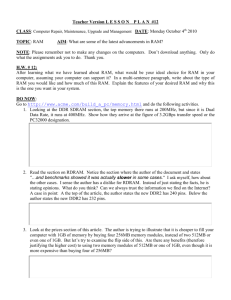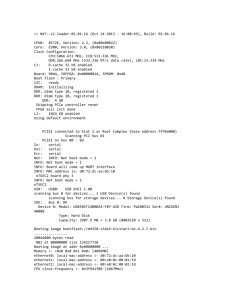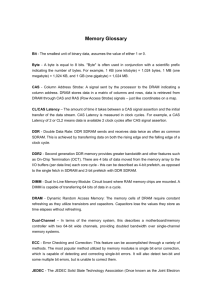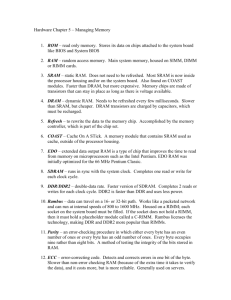ddr sdram
advertisement
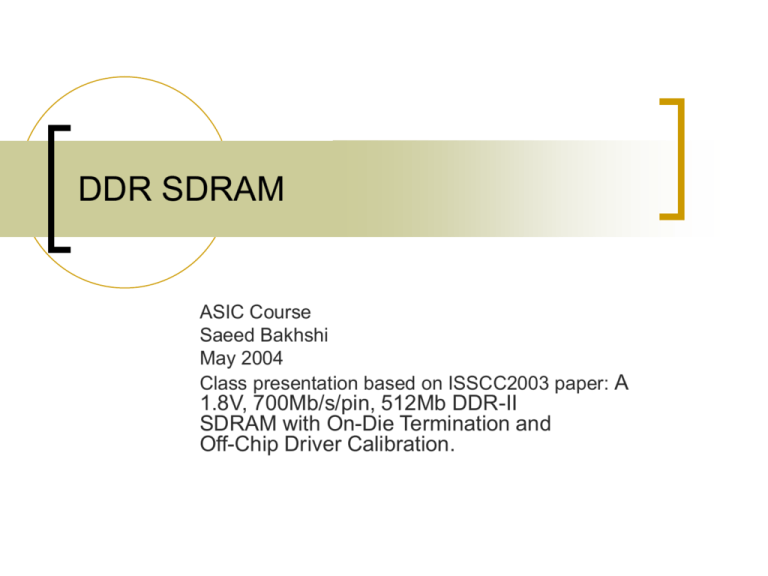
DDR SDRAM ASIC Course Saeed Bakhshi May 2004 Class presentation based on ISSCC2003 paper: A 1.8V, 700Mb/s/pin, 512Mb DDR-II SDRAM with On-Die Termination and Off-Chip Driver Calibration. Outlines Memory Evolution What is DDR? DDR Architecture High Speed Memory Design Considerations DDR-II Architecture A 1.8V, 700Mb/s/pin, 512Mb DDR-II SDRAM with On-Die Termination and Off-Chip Driver Calibration A paper from: ISSCC 2003; Session 17.8 Samsung Electronics History of Memory Memory Evolution Only a few years ago, "regular" SDRAM was introduced as a proposed replacement for the older FPM and EDO asynchronous DRAM technologies. 1979 DRAM 1997 SDRAM Next Generation Memories RAMBUS, DDR SDRAM This was due to the limitations the older memory has when working with systems using higher bus speeds (over 75 MHz). In the next couple of years, as system bus speeds increase further, the bell will soon toll on SDRAM itself. One of the proposed new standards to replace SDRAM is Double Data Rate SDRAM or DDR SDRAM. What is DDR? DDR (Double Data Rate) memory is the next generation SDRAM. Like SDRAM, DDR is synchronous with the system clock. The big difference between DDR and SDRAM memory is that DDR reads data on both the rising and falling edges of the clock signal. SDRAM only carries information on the rising edge of a signal. Basically this allows the DDR module to transfer data twice as fast as SDRAM. For example, instead of a data rate of 133MHz, DDR memory transfers data at 266MHz. DDR SDRAM also consumes less power, which makes it ideal for notebook computers. JESD79C is the JEDEC standard for DDR SDRAM specifications. DDR Terminology Name Clock Freq. Data Rate DDR200 DDR266 DDR333 DDR400 100 MHZ 133 MHZ 167 MHZ 200 MHZ 200 MHZ 266 MHZ 300 MHZ 400 MHZ DDR Architecture The DDR SDRAM uses a double data rate architecture to achieve high speed operation. The double data rate architecture is essentially a 2n prefetch architecture, with an interface designed to transfer two data words per clock cycle at the I/O pins. A single read or write access for the DDR SDRAM consists of : Single 2n-bit wide data, in one clock cycle is transferred at the internal DRAM core. Two corresponding n-bit wide data, in two-half clock cycle, are transferred at the I/O pins. DDR Architecture DDR Architecture Data Input Sampling DIND : Input data after Din buffer PE : Pulse generated by the rising edge of DQS PO : Pulse generated by the falling edge of DQS PCK : Internal Pulse generated by the rising edge of CLK DDR Architecture Output Driver Voltage mode push-pull driver ; small rON DDR Architecture SSTL stands for Series Stub Terminated Logic and has been defined and standardized within JEDEC. Series resistors are incorporated in the SSTL signaling technology for main memory applications. These resistors can be very effective in dissipating any reflected wave energy traveling along the module traces and isolating the module stubs from the main memory bus. Proper termination of the bus transmission lines, reducing signal reflections. The result is improved signal quality, higher clock frequencies, and lower EMI emissions. SSTL inputs are typically a differential pair common source amplifier with one input tied to the VTT reference. This type of circuit provides excellent gain and bandwidth. High Speed Memory Design Considerations The Signal integrity is an challenging issue in High speed design. The following effects are more important in High Speed Design and can cause data corruption. Reflection Crosstalk and interference SSN (simultaneously switching noise) Following solutions are employed to improve signal integrity. On die Termination (ODT) Off chip Driver Calibration (OCD) On die Decoupling DDR II In JEDEC, DDR-II targeting 667Mb/s/pin is being defined as an extension of DDR. Interface is defined at VDDQ=1.8V. SSTL bus structure has been modified for higher data rate. ODT (On Die Termination) is employed for better signal integrity. DDR2 SDRAM introduces features and functions that go beyond the DDR SDRAM specification and enable DDR2 to operate at data rates of 400 MHz, 533 MHz, 667 MHz, and above. DDR II Normal DDR limitations at higher frequencies: DDR2 Addresses these challenges by: Signal integrity Power Consumption Operating voltage is reduced from 2.5V to 1.8V Reduced core operating frequency Core frequency = 1/2 the I/O frequency Special New Features: 4-bit pre-fetch On-die termination Off-chip driver calibration DDR Evolution DDR and DDR-II DDR-II Architecture 4-bit Pre-fetch Single Data SDRAM In most DRAMs, the core and the I/O logic are running at the same frequency. In SDRAM each output buffer can relase a single bit per clock cycle. DDR (I) In DDR, every I/O buffer can output two bits per clock cycle. Each read command will transfer two bits from the array into the DQ. Since the data are fetched from the array before they are released, the memory parlance describes this as "prefetch of 2". The simplest way to conceptualize this is to use two separate data lines from the primary sense amps to the I/O buffers. The DQs are then outputting the data in a time multiplexed manner, meaning one bit at a time on the same output line The easy way to do this is to collect the two bits in two separate pipeline stages and then release them in the order of the queue on the rising and the falling edge of the clock. Because two bits are released to the bus per pin and clock cycle, the protocol used is called double data rate or DDR. 4-bit Pre-fetch DDR2 SDRAM achieves high-speed operation by 4-bit prefetch architecture. In 4-bit prefetch architecture, DDR2 SDRAM can read/write 4 times the amount of data as an external bus from/to the memory cell array for every clock, and can be operated 4 times faster than the internal bus operation frequency. ODT ( On-die termination ) On-die termination (ODT) has been added to the DDR2 data signals to improve signal integrity in the system. The termination value of RTT is the Thevinen equivalent of the resistors that terminate the DQ inputs to VssQ and VDDQ. An ODT pin is added to the DRAM so the system can turn the termination on and off as needed. ODT (On Die Termination) ODT (On Die Termination) OCD( Off Chip Driver Calibration) It is true that lower voltage swings enable higher frequencies but after a certain point, the ramping of the voltages will show a significant skew. The skew can be reduced by increased drive strength, however, with the drawback of a voltage overshoot / undershoot at the rising and falling edges, respectively. One additional problem with high frequency signaling is the phenomenon of trace delays. The solution in DDR was to add clock forwarding in form of a simple data strobe. DDR II takes things further by introducing a bidirectional, differential I/O buffer strobe consisting of DQS and /DQS as pull-up and pull-down signals. Differential means that the two signals are measured against each other instead of using a simple strobe signal and a reference point. In theory the pull-up and pull-down signals should be mirror-symmetric to each other but reality shows otherwise. OCD( Off Chip Driver Calibration) One way to solve the problem is to use Off-Chip Driver calibration (OCD calibration) where both parts of the differential strobes are calibrated against each other and against the DQ signal. Through this sort of calibration, the ramping voltages are optimized for the buffer impedances to reduce over and undershooting at the rising and falling edges. Without OCD calibration, the DRAM has a nominal output driver strength of 18 ohms +30% and a pull-up and pulldown mismatch of up to 4 ohms. Using OCD calibration, a system can reduce the pull-up and pull-down mismatch and target the output driver at 18 ohms to optimize the signal integrity. OCD( Off Chip Driver Calibration) DDR, DDR2 Comparison Table ISSCC 2003; Session17; SRAM and DRAM Memory A 1.8V, 700Mb/s/pin, 512Mb DDR-II SDRAM with On-Die Termination and Off-Chip Driver Calibration C. Yoo, K. Kyung, G. Han, K. Lim, H. Lee, J. Chai, N. Heo, G. Byun, D. Lee, H. Choi, H. Choi, C. Kim, S. Cho Samsung Electronics, Hwa-Sung, Korea Abstract: A 1.8V 700Mb/s/pin 512Mb DDR SDRAM is JEDEC standard compliant With the hierarchical I/O line and local sensing. For signal integrity at 533Mb/s, off-chip driver calibration and on-die termination are employed. Contents Introduction Data Path Architecture Signal Integrity (SI) Improvement Hierarchical I/O with Half-Vcc Precharge Off-Chip Driver (OCD) Calibration On-Die Termination (ODT) Conclusion Introduction High Performance DRAM Trend Fast Access Time High Data Rate Low Power Consumption 512M SDRAM with Improved Performance Fast Access time by employing Hierarchical I/O On-die termination & off-chip driver calibration : sufficient signal integrity for > 533Mbps Low voltage operation : 1.8V CHIP Architecture Data Path Architecture Hierarchical I/O with Half-VCC Precharge During read, the loading of GIO lines is decoupled from LIO lines, resulting in improved read access time. Data Path Architecture For fast access time, the data lines from the array have hierarchical structure as local I/O (LIO) and global I/O (GIO) lines. The GIO/GIOB and LIO/LIOB lines are precharged to VccA/2. The loading of GIO lines decoupled from LIO lines, improves the read access time by 3.5ns. The Precharge time would be too long if the Precharge level were VccA . Real cycle time reduction by 4.23ns. Data Path Architecture Signal Integrity Improvement Off-Chip Driver Calibration On-Die Termination The strength of DRAM off-chip driver is calibrated interactively. Termination resistors are placed inside DRAM and chipset instead of the motherboard. Better signal integrity than motherboard terminated bus topology. timing improvement by 130 ps. Off-Chip Driver Calibration Variable strength for Drivers. During OCD calibration mode, chipset sets the control codes. On Die Termination Same structure as OCD to have the same on/off delay as OCD delay. Thank You

